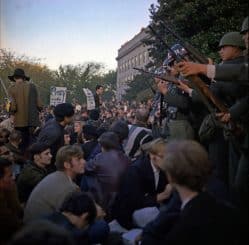
This technique consists of a group of people occupying a public place while sitting on chairs, stools, or even the floor, with the aim of disturbing normal activities.
Historical examples of this technique can be seen in the lunch counter sit-ins during the Civil Rights Movement to protest segregation, and in sit-ins to protest the Vietnam War.
(You can read more about the different methods of nonviolent protest in Gene Sharp’s book The Politics of Nonviolent Action. Access CSA’s catalogue of Sharp’s methods here, or download the full list of 198 methods here.)


